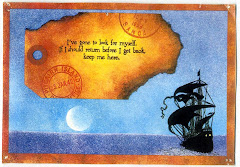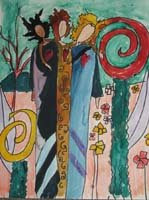It was 64 degrees F. in Bismarck yesterday, breaking a record for March 10 that had stood since 1900!
It was a day for almost all the snow to melt away, for the dogs to drag in tons of mud, for the geese to fly north, for me to buy a bunch of sunny yellow tulips and to just stand and bask in the sun and the warm wind.
Last night on the news the meteorologist said this wind came flowing down the eastern slopes of the Rocky Mountains and across Montana to reach us. As a prairie girl, I've known about these chinook winds since childhood, but I didn't know a lot about them.
I did some research on chinooks yesterday, and here's some of what I found:
Chinooks are more accurately called Föhn winds by meteorologists and climatologists. They are called chinooks throughout most of western North America, especially in the Rocky Mountain region. Montana in particular has a significant amount of chinook winds.
These winds happen worldwide, wherever big air flows meet mountain ranges. In North America, warm air from the Pacific is one reason why chinooks make thermometer readings soar. Having lost their moisture on the windward side of the mountains, these winds gain even more warmth by a process called compressional heating, as the now dry air descends the leeward side of the mountains.
The term chinook came from the Chinook Indians living along the lower Columbia River west of the Rockies. Metis and French voyageurs of the fur companies brought the term (pronounced "shinook") from the mountains to the prairies.
Winds of this type are called "snow-eaters" for their ability to make snow melt or sublimate rapidly.
A strong Chinook can make foot-deep snow almost vanish in one day. Chinook winds have been observed to raise winter temperatures by as much as 70 degrees for a few hours or days. The greatest recorded temperature change in 24 hours occurred on January 15, 1972, in Loma, Montana. The temperature rose from -48°C (-54 F) to 9°C (49°F), a 103 degree F difference.
The world's fastest recorded rise in temperature occurred in Spearfish, SD. At 7:30 am on January 22, 1943, the temperature there was -4 °F (-20 °C). A chinook kicked in, and two minutes later the temperature was 45 °F (7 °C) above zero. The 49 degree (27 °C) rise in two minutes set a world record that is still on the books. By 9:00 am, the temperature had risen to 54 °F (12 °C). Suddenly, the chinook died down and the temperature tumbled back to -4 °F. The 58 degree drop took only 27 minutes.
There are two especially famous Canadian chinook folk tales:
* A man rode his horse to church, only to find just the steeple sticking out of the snow. So, he tied his horse to the steeple with the other horses, and went down the snow tunnel to attend services. When everybody emerged from the church, they found that a chinook had melted all of the snow, and their horses were now all dangling from the church steeple.
* A man was riding his sleigh to town when a chinook overcame him. He kept pace with the wind, and while the horses were running belly deep in snow, the sleigh rails were running in mud up to the buckboard. The cow that was tied behind was kicking up dust.
In some places, chinook or Fohn winds have strange effects on people. "These warm, dry winds have sometimes adversely affected human behavior,” the editors of the textbook, Meteorology Today wrote. “During periods of chinook winds some people feel irritable and depressed and others become ill. The exact reason for this phenomenon is not clearly understood.”
It is said that chinook winds can lead to sleeplessness, and also cause a sharp increase in the number of migraine headaches suffered by the locals and are often called "chinook headaches". At least one study conducted by the department of clinical neurosciences at the University of Calgary (Alberta) supports that belief. (Calgary also has a high incidence of chinooks, which may have prompted their study at UC.)
These winds are often associated in popular mythology with mental disturbances and illnesses, including psychosis. A study by the Ludwig-Maximilians-Universität München found that suicide and accidents increased by 10 percent during Föhn winds in Central Europe. The cause of Föhnkrankheit (English: Föhn-sickness), however, remains to be proven.

To those unfamiliar with the chinook arch, it may look like a threatening storm cloud at times, but they rarely produce rain or snow. However, they can create stunning sunrises and sunsets, in colors of yellows, oranges, reds and pinks.
Though they weren't as nearly as colorful as those in the above photo, I saw chinook arches while driving westward to work several morning in February. Although those were mild winter days, the spike in temperatures certainly wasn't as dramatic as it was yesterday.
Maybe the winds behind those chinook arches were the cause of my recent strange moods. I love the term "Fohnkrankheit". It's got the word cranky in it, and I certainly was cranky! But yesterday, all I felt was light, happy and hopeful. In any event, I'll take a chinook wind over an Alberta clipper any day!
































9 comments:
I have heard of Chinooks naturally, living in Canada. Unfortunately their effect is not felt this far East. It is supposed to warm up this week, so I'm hoping the snow piles will diminish. This was a really interesting post Julie, I learned a lot.
hugs
xx
I haven't heard that expression "Chinook" in a LONG time. HA! I know deal with hurricane catagories instead! That was very interesting reading. I had heard that the snow was melting up there rapidly. Must be that Crazy Chinook I suppose.
Thanks for the information.
When I lived in Edmonton, a 3 hour drive north of Calgary, I would watch with envy when Calgary got a chinook. In the dead of the long, cold winter I was envious of the warm break it would get. I hadn't heard of an Alberta Clipper until I read it on one of your posts.
I, for one, am sick of winter and want to feel the warm air of spring; to hear the chirping birds and to smell the beginnings of flowers in bloom.
The weather where you live is certainly dramatic! We have had a couple of balmy days here, after snow last week!
The yellow tulips are lovely!
Apparently our current big winter storms right now (high winds combined with high tides - not good on the coast) are due to Canadian winds!!!!
Thanks
Send one of those Chinook winds over here please! lol I need something to get rid of all this snow we have. Sigh. Being Canadians, we learn about the Chinooks in grade school but I don't live in an area where we have them. Such an interesting post, dear Julie, and I loved seeing that picture of what a Chinook looks like...awesome! xox
I reside in Colorado Springs. Believe me, the Chinook winds are not something to be envied! Everything aches. Your brain blinks and goes off. Trees and fences fall, debris rolls across the landscape. Sales drop because folks hunker down. Even the dogs mope.
Just sayin'.
Lois, for you, living so close to the Rockies, the chinook must be like the Mistral for the French. But for those of us in western ND, the chinook was mild and oh-so welcome.
Can't imagine it being mild, but I'm glad for you! Pikes Peak, @ over 14,000 is practically in our back yard. This is the first day with gentle winds in about 3 weeks and everyone is outside. 8->
Post a Comment